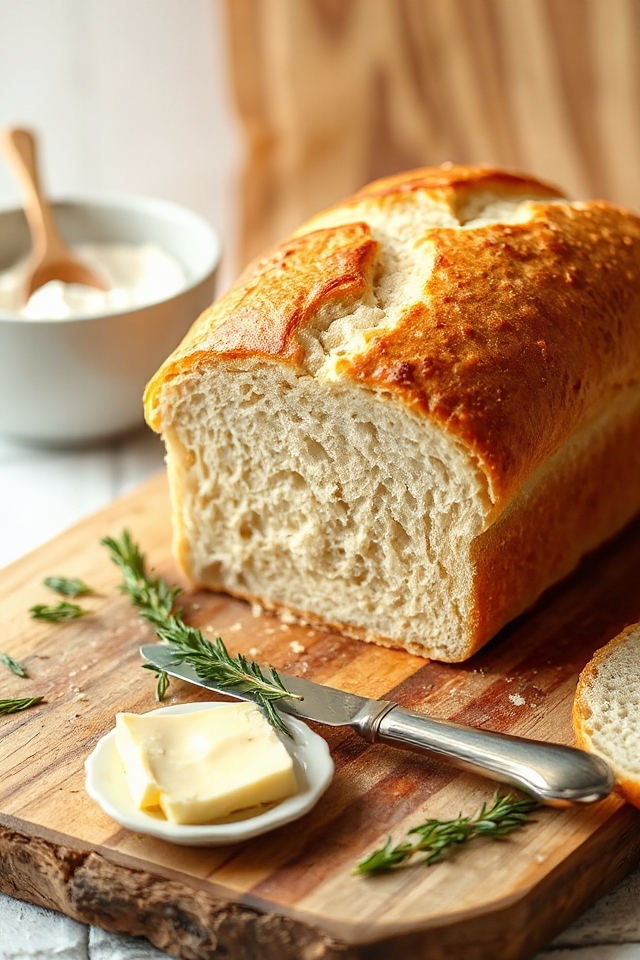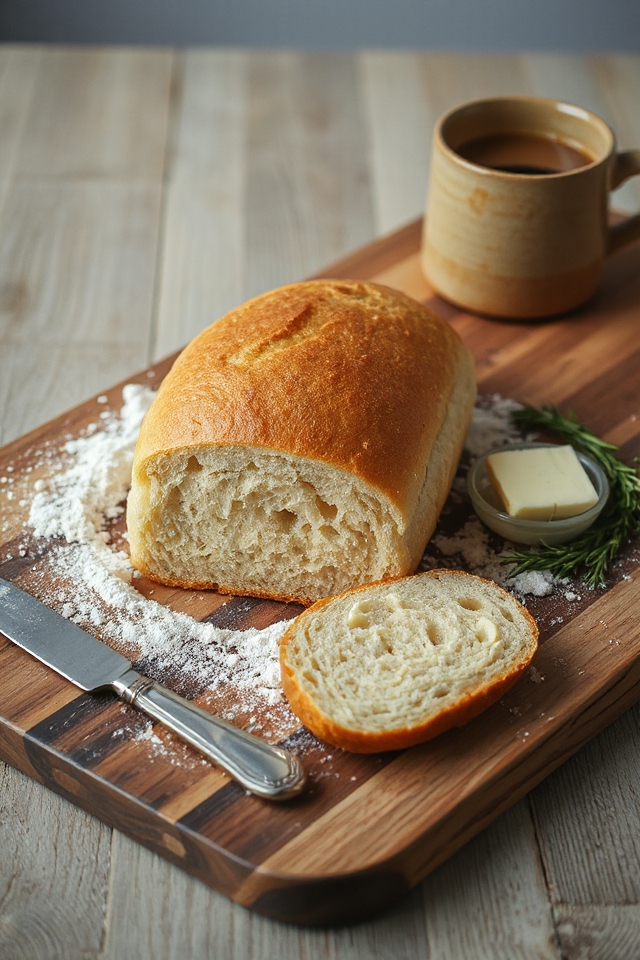Why You’ll Love This White Bread Recipe
You’ll love this white bread recipe because it combines simplicity with incredible flavor.
I can’t tell you how satisfying it’s to knead the dough and watch it rise. The aroma that fills my kitchen while it bakes is simply irresistible.
Each slice is soft, fluffy, and perfect for sandwiches or toast. Plus, it’s a great way to impress family and friends!
I appreciate how quickly I can whip it up, making it an ideal choice for any occasion.
Trust me, once you try this recipe, you’ll want to make this delicious bread again and again.
Enjoy every bite!
Ingredients of White Bread
When it comes to baking white bread, the ingredients you choose are just as important as the method. The right combination of flour, yeast, and a few special touches can take your bread from ordinary to extraordinary.
So, let’s gather what we need to commence on this delicious journey together, shall we? It’s always a good idea to have everything prepped and ready to go before we start mixing. Trust me, it makes the process smoother, and you won’t end up searching for that elusive bag of flour halfway through.
Here’s what you’ll need to whip up this delightful white bread:
- 4 3/4 cups bread flour
- 1 1/2 teaspoons salt
- 1/4 cup powdered milk
- 3 1/4 tablespoons granulated sugar
- 2 teaspoons yeast
- 1 beaten egg
- 3 1/4 tablespoons butter
- 1 1/2 cups room-temperature water
Now, let’s talk a bit about these ingredients. Bread flour is your best friend here; it has a higher protein content than all-purpose flour, which gives your bread that lovely chewy texture.
If you’re wondering about the powdered milk, it’s a secret weapon that adds flavor and helps create a soft crumb. And the sugar? It’s not just for sweetness. It feeds the yeast, giving your bread a nice rise and golden crust.
So, feel free to play around with the ingredients a bit, but remember, balance is key. As you get more comfortable, you might even try adding herbs or seeds. Just remember, baking is a science, and a little mess-up here could lead to a bread flop.
But hey, even if it doesn’t turn out perfectly, you’re still making bread, and that’s something to be proud of.
How to Make White Bread

Making white bread is like starting a little adventure in your kitchen. With just a handful of ingredients, you can create something that not only fills your home with a delightful aroma but also tastes incredible. Ready? Let’s jump into the process together.
First, grab your big mixing bowl and toss in 4 3/4 cups of bread flour, 1 1/2 teaspoons of salt, 1/4 cup of powdered milk, 3 1/4 tablespoons of granulated sugar, and 2 teaspoons of yeast. Give that a good mix—this is where the magic starts. The fluffy flour, salty salt, and sweet sugar all come together to create a delicious base for your bread.
Next, you’ll want to pour in 1 beaten egg, 3 1/4 tablespoons of butter (melted, of course), and 1 1/2 cups of room-temperature water. Mix it all until you see all the dry ingredients disappear, forming a lovely, cohesive dough. If it feels a bit stiff—don’t panic! Just add a splash of water until it softens up.
Now comes the fun part—kneading! Transfer that dough to a lightly floured countertop and get your hands working. Knead it for about 6-8 minutes or pop it in a stand mixer with a dough hook on medium speed. It’s a bit of a workout, but trust me, your future self will thank you when you’re biting into that soft, chewy bread.
Once it’s nice and smooth, put it in a lightly oiled bowl, cover it with plastic wrap, and let it ferment at room temperature for about 1 1/2 to 2 hours. It’s like giving your dough a cozy nap until it doubles in size.
After that, you’ll divide it up for loaves or rolls, let it rest a bit more, and then shape it into whatever your heart desires. Finally, bake it at 350°F for loaves or 400°F for rolls or buns, and watch as it transforms into a golden masterpiece.
Just be sure to cool it on a wire rack for at least an hour before slicing—if you can resist that long. Happy baking!
White Bread Substitutions & Variations
While traditional white bread holds its charm, experimenting with substitutions and variations can lead to delightful new flavors and textures.
I often swap out a cup of bread flour for whole wheat or spelt flour for added nutrition. If I’m feeling adventurous, I might incorporate herbs or spices like rosemary or garlic powder.
For a sweeter twist, I’ve used honey instead of sugar, or added chocolate chips for a treat. Dairy-free? No problem—just replace the milk powder with a dairy-free alternative.
Each variation brings a unique character to the bread, making it fun to discover new favorites!
Additional Tips & Notes
To guarantee your white bread turns out perfectly every time, it’s important to pay attention to ingredient temperatures and measurements.
Make certain your water is warm, around 110°F, to activate the yeast effectively. I’ve found that using a kitchen scale for the flour guarantees accuracy and consistency.
If your dough feels too sticky, don’t hesitate to sprinkle in a bit more flour, but avoid overdoing it.
Finally, patience is key; let the dough rise fully to develop that lovely texture. Trust your instincts, and enjoy the process—there’s nothing quite like the smell of fresh-baked bread wafting through your home!
